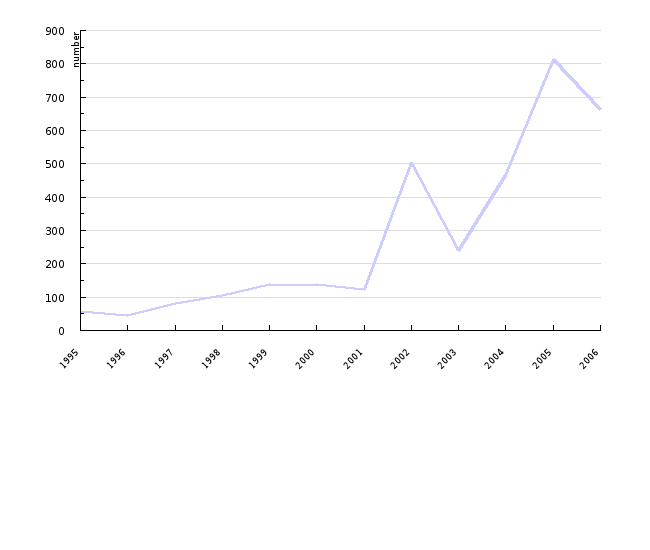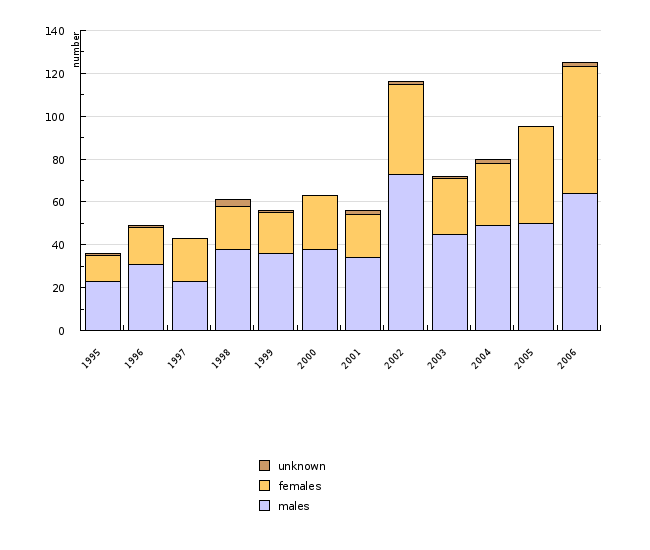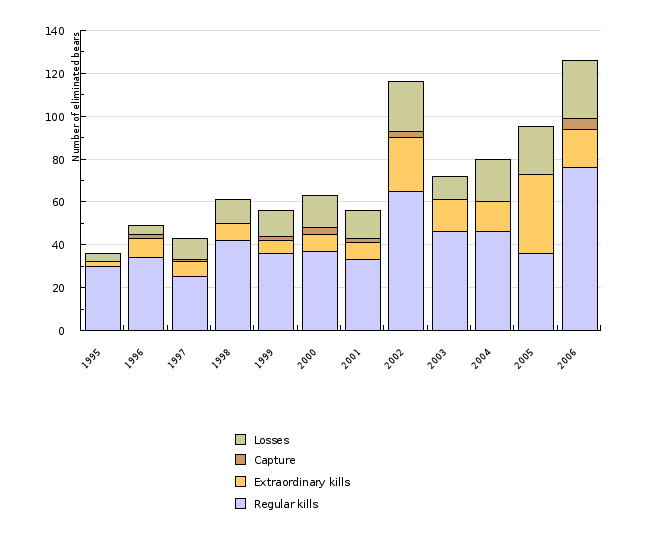[NB06] Brown bear

Key message

The brown bear (Ursus arctos) population in Slovenia forms part of a population whose range lies in the Alps-Dinarides-Pindar mountain range area and which constitutes one of the largest populations in Europe. Its abundance is estimated at roughly 2,100 – 2,500 specimens. The state of the population in Slovenia has been monitored by the Slovenia Forest Service since 2005 and has been rated as favourable. The brown bear is vitally bound to large forest areas, in Slovenia mostly fir and beech forests in the high Kart region. For this reason, the indicator also directly reflects the state of preservation of this forest landscape, to a large extent included into the Natura 2000 network.
Definition
The indicator shows the population state of the brown bear in Slovenia and indirectly the state of preservation of the bear's habitat. It is composed of various subindicators, which show: the gender structure of the specimens which have been eliminated from the wild, various reasons for eliminating specimens from the wild, records of damages caused by the bear to human property and data on bear observations within a network of permanent counting points.
Data have been collected by the Slovenia Forest Service in accordance with a unified methodology since 1995, while animal observations at permanent counting points have been collected since 2003. If differences are measured in the same manner over a longer time period, their past trend sufficiently demonstrates the indicator's state.
Charts
Statistical data on incidents caused by the brown bear to human assets, Slovenia Forest Service, 2007.
| 1995 | 1996 | 1997 | 1998 | 1999 | 2000 | 2001 | 2002 | 2003 | 2004 | ||
|---|---|---|---|---|---|---|---|---|---|---|---|
| incidents | number | 57 | 45 | 81 | 105 | 138 | 139 | 123 | 503 | 239 | 466 |
| damage in EUR | EUR | 11795 | 25621 | 40580 | 120653 | 99825 | 52638 | 44240 | 131377 | 64922 | 124129 |
| 2005 | 2006 | ||||||||||
| incidents | number | 814 | 664 | ||||||||
| damage in EUR | EUR | 197501 | 153544 |
Statistical data on structure of elimination from the brown bear population, Slovenia Forest Service, 2007.
| 1995 | 1996 | 1997 | 1998 | 1999 | 2000 | 2001 | 2002 | 2003 | 2004 | ||
|---|---|---|---|---|---|---|---|---|---|---|---|
| males | number | 23 | 31 | 23 | 38 | 36 | 38 | 34 | 73 | 45 | 49 |
| females | number | 12 | 17 | 20 | 20 | 19 | 25 | 20 | 42 | 26 | 29 |
| unknown | number | 1 | 1 | 0 | 3 | 1 | 0 | 2 | 1 | 1 | 2 |
| males | % | 64 | 63 | 54 | 62 | 64 | 60 | 61 | 63 | 63 | 61 |
| females | % | 33 | 35 | 47 | 33 | 34 | 40 | 36 | 36 | 36 | 36 |
| unknown | % | 3 | 2 | 0 | 5 | 2 | 0 | 4 | 1 | 1 | 3 |
| up to 100 kg | number | 17 | 29 | 28 | 32 | 37 | 41 | 33 | 86 | 53 | 52 |
| from 101 to 150 kg | number | 12 | 15 | 13 | 20 | 7 | 16 | 14 | 20 | 13 | 17 |
| above 150 kg | number | 6 | 5 | 2 | 8 | 11 | 6 | 7 | 9 | 6 | 9 |
| unknown | number | 1 | np | np | 1 | 1 | np | 2 | 1 | np | 2 |
| total | number | 36 | 49 | 43 | 61 | 56 | 63 | 56 | 116 | 72 | 80 |
| 2005 | 2006 | ||||||||||
| males | number | 50 | 64 | ||||||||
| females | number | 45 | 59 | ||||||||
| unknown | number | 0 | 2 | ||||||||
| males | % | 53 | 51 | ||||||||
| females | % | 47 | 47 | ||||||||
| unknown | % | 0 | 2 | ||||||||
| up to 100 kg | number | 69 | 81 | ||||||||
| from 101 to 150 kg | number | 22 | 31 | ||||||||
| above 150 kg | number | 4 | 13 | ||||||||
| unknown | number | np | np | ||||||||
| total | number | 95 | 125 |
Statistical data on the structure of elimination from the brown bear population, Slovenia Forest Service, 2007.
| 1995 | 1996 | 1997 | 1998 | 1999 | 2000 | 2001 | 2002 | 2003 | 2004 | ||
|---|---|---|---|---|---|---|---|---|---|---|---|
| Regular kills | number | 30 | 34 | 25 | 42 | 36 | 37 | 33 | 65 | 46 | 46 |
| Extraordinary kills | number | 2 | 9 | 7 | 8 | 6 | 8 | 8 | 25 | 15 | 14 |
| Capture | number | 2 | 1 | 2 | 3 | 2 | 3 | ||||
| Losses | number | 4 | 4 | 10 | 11 | 12 | 15 | 13 | 23 | 11 | 20 |
| Kills - total | number | 32 | 43 | 32 | 50 | 42 | 45 | 41 | 90 | 61 | 60 |
| Eliminated bears - total | number | 36 | 49 | 43 | 61 | 56 | 63 | 56 | 116 | 72 | 80 |
| 2005 | 2006 | ||||||||||
| Regular kills | number | 36 | 76 | ||||||||
| Extraordinary kills | number | 37 | 18 | ||||||||
| Capture | number | 5 | |||||||||
| Losses | number | 22 | 27 | ||||||||
| Kills - total | number | 73 | 94 | ||||||||
| Eliminated bears - total | number | 95 | 126 |
Statistical data on the monitoring of abundance trends and the population structure of the brown bear, Slovenia Forest Service and Slovenian Hunting Association, 2007.
| spring | autumn | ||
|---|---|---|---|
| female bears with offspring 0+ | % | 8 | 14 |
| female bears with offspring 1+ | % | 11 | 6 |
| offsprnig 0+ | % | 14 | 25 |
| offspring 1+ | % | 21 | 12 |
| other bears | % | 46 | 43 |
Statistical data on the monitoring of abundance trends and the population structure of the brown bear, Slovenia Forest Service and Slovenian Hunting Association, 2007.
| 2004 | 2005 | 2006 | ||
|---|---|---|---|---|
| spring | number | 0.94 | 1.34 | 1.12 |
| autumn | number | 0.94 | 1.48 | 0.94 |
| total | number | 0.94 | 1.41 | 1.03 |
Goals
The goal, as determined by the Resolution on National Environmental Action Plan 2005-2012, is to maintain a favourable state of the brown bear population and to decrease conflicts.
Comment
The brown bear (Ursus arctos) population in Slovenia forms part of a population whose range lies in the Alps-Dinarides-Pindar mountain range area and which constitutes one of the largest populations in Europe. Its abundance is estimated at roughly 2,100 – 2,500 specimens. Based on the monitoring of the population state, the Slovenia Forest Service estimates that the population in Slovenia is in a favourable state and comprises of 500 – 700 specimens.
The brown bear has been included into the Red List of endangered animal species and is classified into category E (endangered species). It is protected by Slovenian, European as well as international legislation, which specify the obligation to monitor the state of species preservation with special attention paid to priority species. The brown bear has been defined as a priority species.
Slovenia has been monitoring the state of the bear population since 2003 on the basis of regular brown bear counting within a network of permanent counting points (3x yearly at 167 points) during full moon and on the basis of recorded signs of the brown bear's presence in hunting reserves with a special purpose. The average number of bears observed per counting point rose from 2004 till 2005 and subsequently began to fall. This indicator was monitored for too short of a period to be able to determine a trend for the brown bear population in Slovenia. Gender and age structure monitoring at the spring and autumn counting shows that in autumn the Slovenian brown bear population comprises at least 14% female bears, which on average maintain 1.82 cubs of up to 1 year of age. During the same period, the offspring share in the first year of age is 25% and in the second life period 13%, therefore the offspring amounts to 38% of the whole population.
Damage caused to human property by the brown bear is determined by authorised damage inspectors, i.e. the Slovenia Forest Service staff. Data have been recorded since 1995. During this period the damage monitoring and compensation payment system has been altered a few times. The subindicator is therefore not necessarily directly linked to the abundance of the brown bear population. The Ministry of the Environment and Spatial Planning took over the compensation payments in 2005 and the payments have since then been recorded in accordance with a unified methodology.
The basis for managing the brown bear population is the Strategy for the management of brown bear (Ursus arctos) in Slovenia, which was adopted by the Government of the Republic of Slovenia in January 2002, and the related Brown bear (Ursus Arctos L.) management action plan in the Republic of Slovenia. In the Strategy, animal elimination from the wild as one of the management measures is divided into: kills of a certain number of bears to ensure harmony with man, extraordinary kills of bears which pose a direct threat to man and his assets, capture of living bears for settlement in nature or relocation to another place in nature, capture of lone cubs or injured animals as well as loss due to animals being run over or any other cause of death. Data on bear elimination from the wild have been kept by the Slovenia Forest Service since 1995. The trend of eliminating the brown bear from the population was on the increase between 1995 in 2006. Regular harvest represents on average 59%, extraordinary harvest 18%, losses 20% and other reasons 3%. Between 1995 and 2006, 40% of bears eliminated from the population were males and 60% were females. Such a ratio implies a deviation from the natural gender structure, since the ratio at birth is as a rule 1:1, and contributes to a higher natality of the population.
Methodology
The indicator has been measured on the basis of the following subindicators:
- Statistical data on the structure of elimination from the brown bear population, which have been kept by the Slovenia Forest Service since 1995 as regards the gender and age ratio as well as the type of elimination. The data are maintained on the basis of all eliminations of individual animals from the population.
- Statistical data on incidents caused by the brown bear to human assets, which have been kept by the Slovenia Forest Service since 1995. The statistics are maintained on the basis of all reported incidents by the parties suffering the damage.
- Statistical data on the monitoring of abundance trends and the population structure of the brown bear, kept by the Slovenia Forest Service and the Slovenian Hunting Association since 2003. The statistics are kept on the basis of population monitoring within a network of permanent 167 counting points performed three times yearly, at a uniformly determined date and time.
Sources:
- Statistical database of eliminations, damage and counts at permanent counting points of the Slovenia Forest Service and the Slovenian Hunting Association.
- Jerina, K., Adamič, M., Marenče, M., Jonozovič, M., 2003. Development of a brown bear population management plan. LIFE Natura III project....













